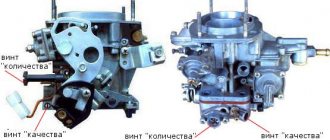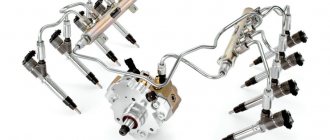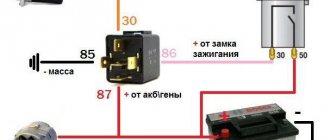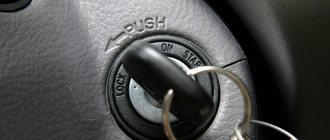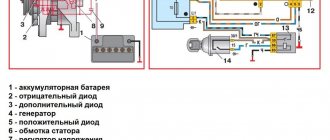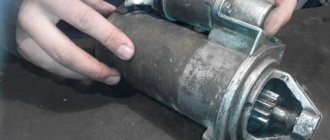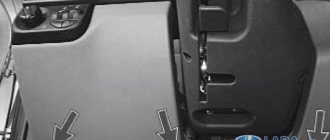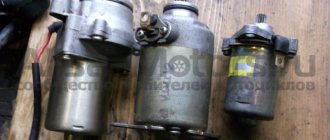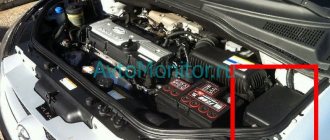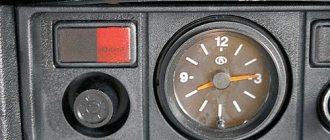The situation when it is impossible to start a car in the morning can unsettle anyone. Such a nuisance seriously spoils the daily plans of a modern person. If the Kia Rio does not start: the starter turns, but the engine does not start, do not panic ahead of time, but try to determine the reason and take action. It won’t always be possible to get by with an immediate repair, but you can try to find the cause yourself. If attempts are unsuccessful or serious repairs are necessary, you should adjust your plans for the day and contact a car service center.
Sulfation of battery plates
The Kia Rio is equipped with a 60 A/h Rocket battery from the factory. This is a good battery, but in some cases it can undergo sulfation - the formation of lead sulfate on the electrodes. As a result, the capacity and starting current of the battery decreases, and the resistance increases. The starter cannot crank the engine normally - the car does not start or starts on the third attempt.
Sulfation of lead battery plates
Why does battery sulfation occur:
- Vehicle operating conditions. A striking example is driving short distances. Over 5-10 kilometers, the generator cannot replenish the charge lost by the battery during a night of inactivity and a couple of engine starts. When operating the car in this mode, do not be lazy to periodically recharge the battery with a charger.
- Problems with the generator. The device may produce too little or too much voltage. A voltage of 14.3-14.7 V without load is considered normal. If it is higher or lower, there is a problem. In the case of the Kia Rio, you need to “dig” towards the voltage regulator.
Sulfation is a phenomenon that can be avoided. But for this you need to regularly monitor the condition of the battery and generator. There are a number of examples where standard batteries on a Kia Rio lasted for 5-7 years.
Kia Rio 3 won't start
Modern batteries are in most cases maintenance-free, so there is no need to add anything to them. Gentle charging mode per amp takes a long time, but allows you to fully restore energy.
Well, replacing the battery is generally a simple matter. There are a lot of worthy manufacturers, the average service life is about 5 years, and this is if the battery is not subjected to deep discharges. Some useful tips The manufacturer indicates clear deadlines for replacing certain consumables and servicing a wide variety of components.
Burnt dimples of the starter solenoid relay
After starting the car, the starter continues to turn. It’s hard not to notice – the noise will be heard even inside the car. A common cause is sticking of the “nickels” (contact plates in the solenoid relay). Nickels can also burn. Because of this, the retractor stops working. The starter does not turn, or starts 2-3 seconds after turning the ignition key.
Starter solenoid relay nickels
The retractor relay on the Kia Rio is located in a very dirty place - dust and water constantly fall on it. And if you consider that the inrush current during startup can reach up to 500 A, it is not surprising that the contacts burn out and the starter does not turn.
After 100-150 thousand kilometers, the copper coins wear off - the contact area decreases and the resistance increases. If the engine does not start or starts on the second or third try, you need to disassemble the relay and check the condition of the plates. If you do this later, you may simply burn the mechanism.
It is important to know: if burnt coins of the starter solenoid relay are found, you should check and clean the seats before replacing them. The presence of soot is unacceptable.
A little about the history of the model
The first generation of Kia Rio appeared back in 2000. Then the car was equipped with a 1.5 liter engine, 5-speed manual and 4-speed automatic. If the base engine produced only 95 hp, then the models exported to the USA were more powerful. The 1.5 l was similar, and the 1.6 l produced about 105 l/s. Models for the European market were equipped with a 1.3 liter power unit with a capacity of 75 l/s.
In 2005, the second generation appeared. Korean cars were also sold in sedan and hatchback body styles. The consumer was offered a choice of three power units:
- 1.4 liters with a capacity of 95 l/s;
- turbocharged diesel with a volume of 1.5 liters and a power of 110 l/s;
- a modernized version of the 1.6-liter engine with a power of 112 l/s.
The latest generation has been produced from 2011 to the present day. There are several powertrain options: 1.4 and 1.6 liters. The model in the basic configuration costs 650 thousand, and in the maximum configuration – 850 thousand rubles.
THE PROBLEM IS THIS: The key is on “START” - there are clicks from under the hood, it seems like two, and it won’t start. By jerking the key back and forth like this 15-20 times, it starts. The battery spins a little and it starts. Changed the retractor. I cleaned the ground and cleaned the contacts on the battery. everything is useless. And a very interesting click is heard right behind the glove box. I took it off and it clicks right here somewhere, but I don’t understand where.
I'll tell you right away. I wrote about this problem on one forum, and after 5 minutes ADMIN said “this is a solenoid relay,” “read the forum,” and closed the topic. And what do you think? I ordered a retractor, received it 2 weeks later, installed it, but the problem remained. Conclusion - let others speak. I READ
about a similar problem here. his battery died.
Tell the experts, maybe some fuse has died? Maybe it’s some kind of sensor that is not working, for example the Start Prohibition Switch (this is the first time I’ve heard about it, I read it in the MANUAL)
Probably the storter is moping, the commutator is burnt out, or the brushes are not fitting well to the commutator. Or maybe the brushes were worn out on the starter. In a word, when starting, the retractor bridges the contacts, the bendex engages, but on the starter itself there is no contact on the brush or brushes.
Definitely brushes or commutator. You need to disassemble, look, clean if necessary. Assess the condition of the brushes and most likely replace them.
Capella Wagon, GWEW-201957, 2.0 FS-ZE (170 hp), 2WD, 2000
Cheer up guys
THE PROBLEM IS THIS: The key is on “START” - there are clicks from under the hood, it seems like two, and it won’t start. By jerking the key back and forth like this 15-20 times, it starts. The battery spins a little and it starts. Changed the retractor. I cleaned the ground and cleaned the contacts on the battery. everything is useless. And a very interesting click is heard right behind the glove box. I took it off and it clicks right here somewhere, but I don’t understand where.
I'll tell you right away. I wrote about this problem on one forum, and after 5 minutes ADMIN said “this is a solenoid relay,” “read the forum,” and closed the topic. And what do you think? I ordered a retractor, received it 2 weeks later, installed it, but the problem remained. Conclusion - let others speak. I READ
about a similar problem here. his battery died.
Tell the experts, maybe some fuse has died? Maybe it’s some kind of sensor that is not working, for example the Start Prohibition Switch (this is the first time I’ve heard about it, I read it in the MANUAL)
Behind the *glove compartment* the fuel pump relay clicks, although it is located at the passenger’s feet along with the *brains*.
Bad mass
The worse the grounding, the more problems with starting. If the battery is in order, the relay does not click and does not turn the Kia Rio starter, you need to look at the ground wires. In general, poor contact between the “mass” is a common illness among “Koreans.” The factory does not bother with the quality of the ground wires - sometimes the terminals are simply screwed on with paint. Wire 918604L200 is especially troublesome. Dirt and moisture get onto the terminals, so the contact quickly oxidizes. At some points the wire simply breaks, which is why the starter does not turn. Problems begin not only with the launch. On Kia Rio, sensors, alarms, autostart and the engine control unit itself are faulty.
Kio Rio ground wire
People struggle with the problem in different ways - someone changes the wire to a new one (factory or reinforced), someone throws additional “mass” on the body. Both methods have the right to life, so you can choose either one.
Advertisements on NN.RU - Auto
The broken-type towing platform produced in our company has a highly reliable design, which is confirmed by many years of use.
Lengthen Gas 331043, 331063 Valdai-farmer for installation of a body 5.1/6.5 m. The chassis is lengthened by increasing the wheel size.
A specialized company for converting trucks into tow trucks invites you to install a tow truck platform on.
Extend the chassis (frame) on Gazelle Next, Gazelle farmer under a body of 4.2 m, 5.1 m and 6.2 m. Extend the frame on Gazelle Next, Gazelle Gas 3302. Price: 25,000 rubles.
If you heard Dmitry Bykov on the radio, read his columns, books, articles, came to lectures, you do not know him. He is a poet.
Thick oil
It is advisable to change engine oil before winter. It's not just about wear, but also viscosity. For the winter, it is better to choose a thinner oil for Kia Rio. In winter, it is difficult for the starter to turn the crankshaft, which is in thick, frozen oil.
Motor oil viscosity
Which viscosity should I choose? You need to think correctly - not every motor can handle 0W. In the case of the Kia Rio, we look at the tolerances and see that the most “liquid” oil is 5W. Most Rio owners use 5W30 oils. Synthetics or semi-synthetics is everyone’s business.
It is important to know! Using viscous oil, the engine will experience oil starvation when starting - the lubricant cannot pass through the pump in full. After winter, seizures may form on such an engine.
Starting system
Malfunctions in the starting system occur due to starter malfunctions. There are five reasons for failure:
- The starter does not respond when the key is turned in the ignition coil: the solenoid relay does not work, there is an open circuit or short circuit in the electrical circuit at the contact terminals.
- The starter operates without starting the engine with characteristic clicks: malfunctions in the electrical wiring, malfunction in the winding of the traction relay or armature.
- The starter turns slowly, the engine does not start: the traction relay does not work, contamination and broken contacts on the brushes, commutator, short circuit in the armature winding.
- The starter operates without turning the flywheel with possible noise, grinding: mechanical failures in the elements of the drive gears, gear teeth, return or buffer springs, lever, or loosening of the starter fasteners to the engine crankcase.
- The starter continues to operate after starting - in this case, it is necessary to turn off the engine: the contacts of the traction relay are closed, the return clutch is broken.
Depending on the nature of the malfunction, you can operate the engine, drive to the nearest car service center and fix the problem, or replace the starter with a new one.
Immobilizer
Perhaps one of the most vile systems that causes problems for Kia Rio owners within a year. It looks like this: the starter turns, but the car does not start. The car starts 5-7 times. Sometimes the car starts the first time, but the problem occurs again. Maybe the battery in the ignition key is dead? We change it, but the car won't start again. What is the reason? You need to look towards the immobilizer. First, check the contacts on the block. The terminal contacts often oxidize, or moisture gets inside. We clean, dry, and see the result.
Immobilizer operation diagram
If everything is still the same, we inspect the antenna. Cleaning contacts. If the immobilizer does not respond, we replace the antenna with a new one. If an immobilizer bypass was installed in the car, be sure to check it. Often the reason is precisely the lineman - replacing it solves the problem forever.
Causes and Troubleshooting
The most common case is when the Rio engine does not start, the starter turns. In this case, the battery has the necessary charge to ensure correct starting. Accordingly, the options for this behavior of the car are as follows: incorrect operation of the fuel supply, interruptions in the ignition, or a malfunction of the engine or its control system. Lack of ignition or fuel supply are the most likely reasons why it is impossible to start the power unit.
Let's move on to identifying the reasons. The first step is to test the performance of the ignition system. Rio has a classic scheme, its work is represented by three phases:
- Low voltage – ignition switch and battery
- High voltage – armored wires and coils
- Fuel ignition - spark plugs
Signaling
Starting problems also occur due to the alarm. This often happens when the power is turned off, that is, when the terminal was removed during repairs or the battery was changed. Our alarm system thinks that the car has been stolen and is blocking the start. Depending on the model, the starter is blocked (due to which it does not turn), or the fuel pump is blocked (the engine turns, but does not start). You can solve the problem by setting the alarm to service mode. In some models, this can be done from the key fob, but often you have to climb to the block itself, which is usually hidden in the depths of the panel.
Kia Rio alarm unit
Other “adventures” also happen - the fuse of the signaling unit or relay burns out. Having replaced the relay or fuse, the car starts as if nothing had happened.
How to replace spark plugs?
This is quite easy to do on a Kia Rio. The first step is to pull off the high-voltage wires from the spark plugs, unscrew the old spark plugs and screw in the new ones. The latter are best ordered original. They have a fairly high service life and decent quality. Another important nuance is the tightening torque. It should be about 20-25 Nm. If you overtighten the spark plug, you can damage the thread so much that you will have to drill it out later. If the tightening torque is insufficient, then further unwinding from vibration is possible, which will be accompanied by tripping of the power unit. Replacing spark plugs on a Kia Rio should be done every 60,000 kilometers. But if the car is used in harsh climatic conditions or in the city, then it is better to replace it more often.
Let's sum it up
There are many reasons for a car to start poorly - the problem can be hidden in any of the systems. It can take a long time to find a fault yourself, and you often need special tools and equipment. By turning to a competent diagnostician for help, you will eliminate the essence of the problem without changing everything in the hope that it will start soon. In the future, so that the car does not fail on the road, we recommend performing preventive measures:
- battery;
- generator;
- starter;
- ignition systems (spark plugs, high-voltage wires and coils);
- fuel supply systems (cleaning injectors, replacing filters).
This will minimize the risk of a failed launch. Have your car serviced on time and diagnosed by trusted specialists!
Checking high voltage wires
The test is carried out on the central wire. The end part is removed from the distributor. Bring the tip closer to any metal element of the car that is well connected to the ground (“bare”, painted - no difference) at a distance of 4-8 mm from each other.
The engine is cranked by the starter, that is, it is as if we are trying to start with the key. If a spark is present, which can be confirmed by a strong click, then the scope of troubleshooting is narrowed. You need to look under the distributor cap. There may be water there. In this case, the current does not reach the spark plug. The distributor must be cleaned and dried. If possible, carry out the same procedure with contacts - for example, with 220-grit sandpaper.
When examining, pay attention to the “runner”. Sometimes there is a dark mark on it, indicating a breakdown. Treatment is only a replacement.
The second stage is checking each wire running from the distributor to the spark plug. There are no signs of deformation - the distributor cover is closed and the connection is restored. They try to start the car. It is either starting to work properly or is already showing signs of improvement. However, after the procedure you will have to unscrew the candles, because they are now filled with gasoline. Even if the car is again in the “starter turns but does not start” mode, this manipulation will still be required. Inspection, cleaning, and replacement will not be superfluous.
You can check the ignition system with the spark plugs removed. The procedure is as follows:
- a high-voltage wire is connected to the unscrewed spark plugs;
- devices are collected in a bundle;
- along the threaded part they are wrapped together with soft wire, which must be in contact with each candle, but not in contact with the electrodes;
- the wires are attached to the mass.
We turn the engine again with the starter. A spark should jump between each electrode in turn. Then the system is fine.
However, it happens that there is no spark, and this suggests that the high-voltage circuit has nothing to do with it. Diagnosis becomes more difficult. Using a tester, the voltage supplied to the ignition coil is checked. If it is absent, it is obvious: the ignition coil is faulty and needs to be replaced. It happens that dirt gets clogged here, and the current goes anywhere, but not to the spark plug. When cleaning does not help, the coil is truly faulty.
For electronic ignition (for example, there is a switch or sensor in the distributor housing), it will not be possible to make a diagnosis without special equipment.
There are contacts under the 2nd generation Korean distributor cover. Sometimes they oxidize and require sanding with fine sandpaper. Afterwards, the contacts need to be moved a little to close and open the circuit. 12 volts won't do any harm. No tension appears, which means a more difficult stage lies ahead. It is difficult to cope with it on your own.
The appearance of voltage restores the circuit and the car starts. However, it happens that there is no start again, although attempts to turn on appear. Then we return to the stage of turning out the candles.
Fuel supply system
The main indicator in the fuel supply system is pressure. When the ignition is turned on, the fuel pump should start; its operation can be heard before starting. If the ignition works, the starter turns, but the engine does not start, then you need to check the electrical circuit and power to the fuel pump. It is worth considering that a working electric fuel pump starts together with the ignition and creates pressure in the lines. That is, during a short-term repeated attempt to start the engine, this pressure is maintained, which means it is in good working order. Low pressure or its absence in the fuel system is due to three reasons:
- Mechanical failure of fuel pump elements
- Severe contamination of the main fuel filter module or air filter
- Malfunction of the fuel system pressure regulator, fuel sensor failure
The electrical circuit of the fuel pump is first checked from the contacts on the fuses and relays to the wiring and condition of the terminals on the unit itself.
If the electrical wiring is in order, the relay is working and voltage is supplied, then the fuel pump is faulty. The Kia Rio 3 is equipped with a distributed fuel injection system - any illiterate intervention in its elements can lead to more serious consequences, therefore, if faults are detected in the fuel system, you must contact specialists.
Preventing starting problems
Every Rio owner, regardless of the generation of the car and the type of transmission (manual or automatic), must clearly remember the following rules:
- The engine compartment should always be clean (this also applies to the power unit);
- it is necessary to constantly monitor the state of charge of the battery, wires, serviceability of the starter and spark plugs;
- periodically inspect the contacts and remove the oxide film and pockets of corrosion from them;
- change filters in a timely manner;
- Do not neglect carrying out scheduled maintenance at a specialized auto repair center.
It is worth emphasizing here that the unsatisfactory condition of the electrical wiring in the engine compartment is not only one of the reasons why the engine will not start, but can also cause a car fire.
Return to contents
Some useful tips
The manufacturer indicates clear deadlines for replacing certain consumables and servicing a wide variety of components. It is advisable to follow these tips and not leave your car unattended. A timely serviced timing belt is the key to a long life for your engine. Its resource is reduced by bad spark plugs, low quality oil and many other factors.
If the next morning the car refuses to start, then in most cases this indicates the presence of serious malfunctions, although sometimes you can get off quite easily. If the crankshaft sensor fails, then it needs to be changed in any case; there is no point in repairing it. It costs a lot, but without it there won’t even be a spark. Often the sensor remains in a “half-dead” state for quite a long time. Therefore, it happens that the Kia Rio does not start the first time. This is due to the fact that the crankshaft sensor periodically sends incorrect data to the electronic control unit, which regulates engine starting parameters.
